Realty Executives of Northern Arizona
The Grand Canyon is one of the natural wonders of the world, and with good reason.
Here are a few facts about the park that may surprise you:
Although scientists can’t really agree on the exact age of the Grand Canyon, some believe parts of it are 70 million years old!
~According to a study released in 2014, temperature history tests were performed that show at least one section could date back as far as 70 million years. However the general consensus was that much of the Grand Canyon is 5 to 6 million years old.
The oldest human artifact found in the park dates back 12,000 years!
~Some of the artifacts found included pots, jewelry, and animal figurines made from twigs. Some of the earliest Native Americans in the region include the Havasupai Tribe, who have been around the Grand Canyon for 800 years.
The Grand Canyon is so big, it can fit the entire state of Rhode Island in it!
~The Grand Canyon is 1,904 square miles, while Rhode Island is 1,214 square miles.
Weather patterns in different areas of the park can be completely different!
~The mean high temperature at the North Rim is 56°, while the mean high temperature at the South Rim is 63°. The mean high temperature at Phantom Ranch is the warmest at 82°.
Only 30% of the Grand Canyon’s caves have been explored!
~There are about 1,000 caves in the park, but only 335 have been explored and recorded.
The Grand Canyon is one of the most visited national parks in the USA.
~In 2019, The Grand Canyon had 5.97 million visitors. This ranked it second only to the Great Smoky Mountains National Park, which has 12.5 million visitors annually.
Natural fires help maintain the ecosystem and are good for the Grand Canyon!
~Research has shown that fires are actually good for the ecosystem, help thin the forest, and recycle nutrients.
The Grand Canyon is filled with wildlife, including 373 species of birds and 92 species of mammals—and seven endangered species!
~There are also 8,480 known species of invertebrates, 58 species of reptiles, and 18 species of fish. The endangered species include birds, fish, and the Kanab ambersnail.
Lets talk about something besides Real Estate this month;
I recently had the opportunity to listen to Kristin Haskins, the Executive Director of The Arboretum at Flagstaff speak at our local Flagstaff Rotary Club.
Her topic covered a lot of what is happening at the Arboretum and about Native Wildflowers.
About the Arboretum:
The Arboretum at Flagstaff was founded by Frances McAllister in 1981 as a private nonprofit organization under the official name "The Transition Zone Horticultural Institute." While research was the original primary focus, over the years it has become known as a destination for local and out-of-town visitors who want to learn more about the native plants and animals found in northern Arizona, and as a wonderful venue for a wide variety of events and educational programs.
Mission:
The Arboretum at Flagstaffs mission is to increase the understanding, appreciation, and conservation of plants and plant communities native to the Colorado Plateau. We strive to:
Here are some Spring Seeding and Gardening Tips the Arboretum has put out.
So with all that,
I picked up some of their Native Wild Flower Seeds.
Last week on Mothers Day, May 10th I prepared a small bed in the front corner of our lot and planted the seeds.
This will be a fun experiment on how well I prepared the soil, planted the seeds and have been keeping them watered until they sprout.
So every morning and evening, they get a drink, this morning I found 1 lone seed that has sprouted. Our friends Chad and Megan planted theirs on the 3rd and have a lot more up already, so mine I hope are just about ready to wake up.
The plot does not have any morning sun, there is a large Ponderosa Pine tree on the left you do not see and a Blue Spruce on the back right you do see.
The picture direction as you are looking at is pointed pretty close to East. So sun hits this spot about 1:00 p.m. every day.
My goal will be to update you on the garden throughout the summer.
Also in future newsletters I plan to give you more information about the Arboretum at Flagstaff. Kristin has provided a a list of the plants and will get that to you in my next newsletter. There are 16 native plants on the list. If you would like that ahead of time, reach out and I can send to you.
I also asked what book I should get to better understand our local Native Plants, she suggested;
Native Plants for High-Elevation Western Gardens by Jan Busco and Nancy Morin, this book was done in partnership with the Arboretum at Flagstaff
This will be fun to see how well this garden progresses through the summer.
I look forward updating you and please never hesitate reach out.
There are a number of things we can talk about besides Real Estate, so would love to visit
Jeff
About the Author:
|
|
There are so many good things to say about Flagstaff! It has just about everything you’re looking for: mountain hiking, snow sports, beautiful woodlands and outdoor activities galore. And even better, plenty of camping options located close to town.
There are two ways to go camping around Flagstaff: Campgrounds, and Dispersed (free) Camping.
Most campgrounds charge a fee, which coversamenities like bathrooms, water, dumpsters, and campsites with fire rings and picnic tables at each site. You can camp in and around many of the area national parks and monuments. At the more popular campgrounds, seasonal hosts will be there to help you check campsite reservations and answer questions. Sometimes, there is even firewood for sale. Most paid campgrounds within the Flagstaff Ranger District are open seasonally. They are closed in Winter. Nightly campsite fees can range between $15.00-$30.00. Most campgrounds are first come, first served. Here are a few of the more popular campgrounds:
*Lockett Meadow Campground: Stunning views of aspens and the tallest mountains in Arizona. Fall is the peak season. There is no running water.
*Bonito Campground: Located just across the road from the Sunset Crater’s visitor’s center. If you are going to Sunset Crater, park admission includes the Wupatki National Monument. This campground includes running water, fire rings, and flush toilets.
*Canyon Vista Campground: Popular with climbers, it offers a short and easy walk to ‘The Pit’, one of Flagstaff’s most popular sport climbing areas. It is conveniently close to town. You will find running water, vault toilets, and access to a variety of trails.
*Ashurst Lake Campground: This quiet spot is great for fishing. Ashurst Lake is one of the few natural lakes in Arizona, and fishermen will find catfish, trout, and bass here. The campground offers a boat launch, campfire rings, picnic tables, bathroom and running water.
Flagstaff KOA: Offers same amenities as all other KOAs. It is seconds away from Mt. Elden’s hiking trail network, and the Flagstaff mall.
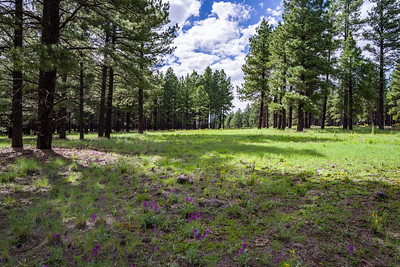 |
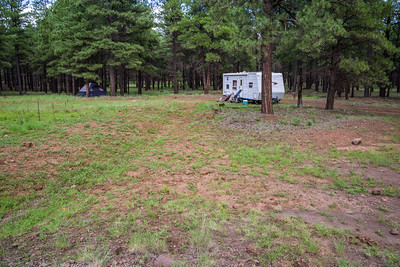 |
Dispersed camping can be had down just about any forest road, away from main highways. With a few regulations, this practice is legal, convenient, and best of all, free. You can find established campgrounds way out in the woods, in the hollowed out core of an extinct volcano, or perched high above lush canyons. Most of the topography around Flagstaff is flat, and there are many miles of forest roads crossing through this whole region. When doing dispersed camping, it is important to realize America’s public lands are a treasured resource. Some principles are obvious, like packing out your trash, or not littering. Still, it is a good idea to read up on the finer points of leaving no trace. Make sure to check for any fire restrictions before setting up that campfire.
Native Americans have played very important roles in our county, past and present. Currently, Arizona is home to 22 Indian tribes. Arizona has the 3rd highest Native American population, with reservations taking up over a quarter of the total land area. The Navajo, Hopi, Havasupai, Kalibab-Paiute, and Hualapai tribal lands alone cover 31,000 square miles of this region.
There are numerous ancient Indian ruins to explore around the Northern Arizona region, the most famous being Wupatki National Monument and Walnut Canyon. Exploring these ancient cliff dwellings, along with Montezuma Castle are definite must-do’s for anyone interested in Native cultures or just looking to take in some fabulous views. If you are really interested in furthering your education, you can plan a visit to the Museum of Northern Arizona in Flagstaff. Check their calendar for the annual special exhibits for both the Navajo and Hopi nations. Various works of art are displayed, along with live demonstrations with some of these very skilled artisans.
And in the more recent past, the Navajo played a huge part in World War II. Have you ever heard of the Navajo Code Talkers? During World War II, the Marine Corps used the Navajo language to create an unbreakable code. The Navajo language seemed to be the perfect option as a code because it is not written and very few people who aren’t of Navajo origin can speak it. During the course of the war, about 400 Navajos participated in the code talker program.
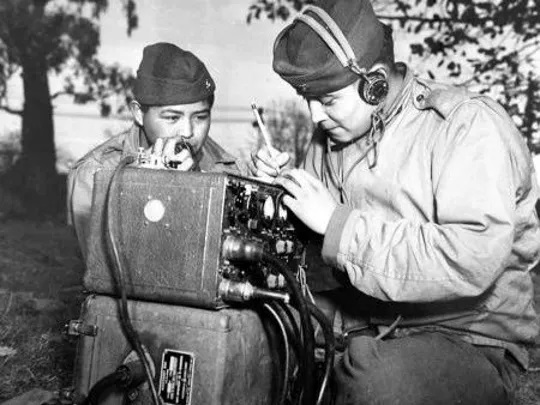 |
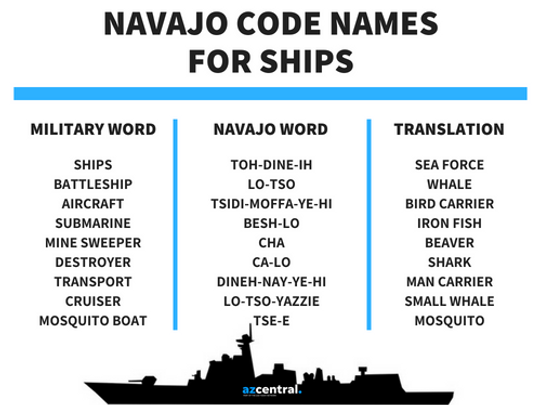 |
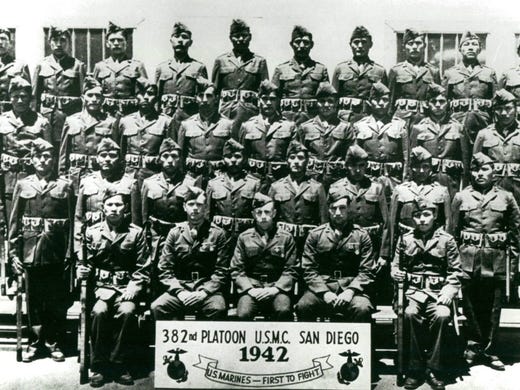 |
The Navajo recruits began developing the code by taking words from their language and applying them to implements of war. For example, the names of different birds were used to stand for different kinds of planes.
The Navajo Code Talkers (who were actually comprised of Navajo, Comanches, Hopis, and others) were treated with the utmost respect by their fellow marines. In 1982, President Ronald Reagan declared August 14 as National Code Talkers Day. In 2000 President Bill Clinton signed a law which awarded the Congressional Gold Medal to the original 29 Code Talkers. President George W. Bush presented the medals to the four surviving Code Talkers at a ceremony held in the Capitol Rotunda in Washington in July 2001.
Want to more more? Check out the Discover Navajo webpage, with links to Museums and more--or the authentic Navajo Code Talkers webpage, filled with photos and even more history!
Some questions to ask your moving company:
A few other questions, tips and ideas for your move:
1. Is moving an essential service in my state?
Check your state’s executive order for essential businesses, and do so frequently as officials update their guidance daily.
2. How do I know if my move is allowed?
While your local officials may deem moving essential, some apartment communities and HOAs are not allowing residents to move during stay-at-home orders. Check with your management company, board, etc. before booking anything for your move.
3.What should I do to best accommodate my moving company?
You should provide a few accommodations to make the move safe for your family and the moving crew, such as:
4. What happens if I need to cancelmy move?
If you need to cancel your moving company, don’t worry. In most cases, booking a moving company is non-binding, allowing you the freedom to cancel at any point prior to your move – without a penalty.
However, if your moving company collected a deposit prior to your move, it may be nonrefundable. Contact your moving company about your deposit. Many reputable moving companies will be flexible or make an exception considering the pandemic. They may refund your deposit or provide credit for a future move.
5. I don’t feel comfortable with others touching my stuff. What are my options?
There are a few things you can do:
You can move using your own vehicle, which is the safest option.
You can rent a truck.
You can rent a container. It’s contactless, and you can pack everything yourself.
6. I want to rent a truck and do it myself. What should I do to ensure my safety?
If you rent a truck, be sure to wear gloves and disinfect the truck’s “hotspots” before getting behind the wheel. This includes the steering wheel, keys, door handles (outside and inside), seats and seat belts, the gear shifter or selector, knobs and buttons on the dashboard, console and touch screens.
7. How do I make sure my things aren’t infected? (boxes, furniture, etc.)
This is a great question because it seems nearly impossible to disinfect every item in every box. If you don’t have to move in right away move your belongings first and then move yourself and family into the house 72-96 hours later.
The New England Journal of Medicine published a study that tested how long the virus can remain stable on various surfaces. They found it was still detectable on cardboard for up to 24 hours and on plastic and steel for up to 72 hours.
If you’re moving at the same time as your belongings, pack on “open first” box or two. When you get to the new home, drop your “open first” boxes in a safe place, and place the rest of your boxes away from them. (You can cover them in colorful tape or use colored markers to make sure they don’t get swallowed up in a sea of other brown boxes.) Prepare to disinfect the box and the items inside.
Here are some items to include:
8.When/how should I clean my new home properly?
Be sure to deep-clean and sanitize your new home before you move into it. Here are a few resources and tips to help:
Use the CDC’s recommendations on how to clean and sanitize your home.
EPA has a list of disinfectants that meet the criteria to fight COVID-19. When purchasing any product, check if its EPA registration number (located on the product label) is included in this list. The products on this list may be marketed and sold under different brand names, but if they have the same EPA registration number, they are the same product.
Use disinfectant wipes for quick cleanings over the most high-touch areas like doorknobs, sinks, cabinet pulls, refrigerators, etc.
Use disinfectant sprays for areas that can’t be wiped clean. You can use Lysol, for example, on your couches and mattresses which will touch many surfaces during a move (the ground, the inside of a truck, etc.).
Use the CDC bleach mixture recommendation on your new tile floors. Use a disinfecting wet mop cloth on your hardwood floors.
As you unpack, be sure to also disinfect your computer and accessories (keyboards can get pretty gross), your television remote controls, credit cards, wallet and more.
9. Is it safe for installation teams to come into my home?
Many television and internet providers now offer self-service solutions for installing new equipment like routers, DVRs and such. If you’re healthy and capable, that’s your best option. Regardless of installation technique, you need to prioritize your internet setup. Under stay-at-home orders, your internet connection is your connection to work, family and friends.
There have been 1-2 hours call wait times, as more and more people call to increase speeds and bandwidth. You can’t bank on getting an appointment as easily as you have in the past. Additionally, you may also want to consider a high-bandwidth plan to account for changes in working from home, video calls and multi-device streaming and more.